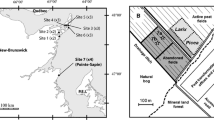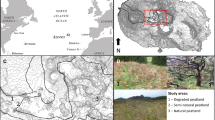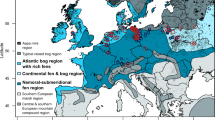Abstract
Sphagnum dominated peatlands do not rehabilitate well after being cutover (mined) for peat and some action needs to be taken in order to restore these sites within a human generation. Peatland restoration is recent and has seen significant advances in the 1990s. A new approach addressing the North American context has been developed and is presentedin this paper. The short-term goal of this approach is to establish a plant cover composed of peat bog species and to restore a water regime characteristic of peatland ecosystems. The long-term objective is to return the cutover areas to functional peat accumulating ecosystems. The approach developed for peatland restoration in North America involves the following steps: 1)field preparation, 2) diaspore collection, 3) diaspore introduction, 4) diaspore protection, and 5) fertilization. Field preparation aims at providing suitable hydrological conditions for diaspores through creation of microtopography and water retention basins, re-shaping cutover fields and blocking ditches. It is site specific because it depends largely onlocal conditions. The second step is the collection of the top 10 centimetres of the living vegetation in a natural bog as a source of diaspores. It is recommended to use a ratio of surface collected to surface restored between 1: 10 and 1: 15 in order to minimize the impact on natural bogs and to insure rapid plant establishment in less than four years. Diaspores are then spread as a thin layer on the bare peat surfaces to be restored. It has been demonstrated that too scant or too thick a layer decreases plant establishment success. Diaspores are then covered by a straw mulch applied at a rate of 3 000 kg ha-1 which provides improved water availabilityand temperature conditions. Finally, phosphorus fertilization favours more rapid substrate colonization by vascular plants, which have been shown to help stabilize the bare peat surface and act as nurse plants to the Sphagnum mosses.
Similar content being viewed by others
References
Beets, C.P. 1992. The relation between the area of open water in bog remnants and storage capacity with resulting guidelines for bog restoration. In: Bragg, O.M., Hulme, P.D., Ingram, H.A.P. and Robertson, R.A. (eds.), Peatland Ecosystems and Man: An Impact Assessment. pp. 133–139. Department of Biological Sciences, University of Dundee, UK.
Boudreau, S. and Rochefort, L. 1999. Établissement de sphaignes réintroduites sous diverses communautés végétales recolonisant les tourbières après l'exploitation. Écologie 30 (1): 53–62.
Brakenhielm, S. and Qinghong, L. 1995. Comparison of field methods in vegetation monitoring. Water, Air, and Soil Poll. 79: 75–87.
Bugnon, J.L., Rochefort, L. and Price, J.S. 1997. Field experiment of Sphagnum reintroduction on a dry abandoned peatland in eastern Canada. Wetlands 17(4): 513–517.
Campeau, S. and Rochefort, L. 1996. Sphagnum regeneration on bare peat surfaces: field and greenhouse experiments. J. Appl. Ecol. 33: 599–608.
Chirino, C.C. and Rochefort, L. 2000. Comportement des sphaignes en phase d'établissement dans une tourbière résiduelle / Establishment response of four Sphagnum species on cutover peatland. In: Rochefort, L. and Daigle, J.-Y. (eds.), Sustaining our Peatlands. Proceedings of the 11th International Peat Congress. Québec City, Canada. August 6–12, 2000. Vol. lI. pp. 694–698.Canadian Society of Peat and Peatlands and International Peat Society, Edmonton, Alberta, Canada.
Clymo, R.S. and Duckett, J.G. 1986. Regeneration of Sphagnum. New Phytol. 102: 589–614.
Crum, H. 1988. A Focus on Peatlands and Peat Mosses. The University of Michigan Press, Ann Harbor, Michigan, USA.
Desrochers, A., Savard, J.P.L. and Rochefort, L. 1998. Avian recolonization in eastern Canadian bogs after peat mining. Can. J. Zool. 76: 989–997.
Ferland, C. and Rochefort, L. 1997. Restoration techniques for Sphagnum-dominated peatlands. Can. J. Bot. 75: 1110–1118.
Grosvernier, P. Matthey, Y. and Buttler, A. 1995. Microclimate and physical properties of peat: New clues to the understanding of bog restoration processes. In: Wheeler, B.D., Shaw, S.C., Fojt, W.J. and Robertson, R.A. (eds.), Restoration of Temperate Wetlands. pp. 435–449.John Wiley & Sons, Chichester, UK.
Grosvernier, P., Matthey, Y. and Buttler, A. 1997. Growth of three Sphagnum species in relation to water table level and peat properties with implications for their restoration in cut-over bogs. J. Appl. Ecol. 34: 471–483.
Johnson, K.W. and Maly, C.C. 1998. Greenhouse studies of Sphagnum papillosum for commercial harvest and peatland restoration in Minnesota. In: Malterer, T.J., Johnson, K.W. and Stewart, J. (eds.), Peatland Restoration and Reclamation. Techniques and Regulatory Considerations. Proceedings of the 1998 International Peat Symposium, Duluth 14–18 July 1998. pp. 49–55. International Peat Society, Duluth, Minnesota, USA.
Johnson, K.W., Maly, C.C. and Malterer, T.J. 2000. Effects of mulch, companion species, and planting time on restoration of post-harvested Minnesota peatlands, U.S.A. In: Rochefort, L. and Daigle, J.-Y. (eds.), Sustaining our Peatlands. Proceedings of the 11th International Peat Congress. Québec City, Canada. August 6–12, 2000. Vol. II. pp. 699–704. Canadian Society of Peat and Peatlands and International Peat Society. Edmonton, Alberta, Canada.
LaRose, S., Price, J.S. and Rochefort, L. 1997. Rewetting of a cutover peatland: hydrologic assessment.Wetlands 17: 416–423.
Lavoie, C., Grosvernier, P., Girard, M. and Marcoux, K. (this issue). Spontaneous revegetation of mined peatlands: an useful restoration tool? Wetl. Ecol. & Manag.
Milliken, G.A. and Johnson, D.E. 1989. Analysis of Messy Data. Volume 1: Designed experiments. Van Nostrand Reinhold, New York, USA. 473 pp.
Money, R.P. 1995. Re-establishment of a Sphagnum-dominated flora on cut-over lowland raised bogs. In: Wheeler, B.D., Shaw, S.C., Fojt, W.J. and Robertson, R.A. (eds.), Restoration of Temperate Wetlands. pp. 405–422. John Wiley & Sons, Chichester, UK.
Money, R.P. and Wheeler, B.D. 1999. Some critical questions concerning the restorability of damaged raised bogs. Appl. Veg. Sci. 2: 107–116.
National Wetland Working Group (NWWG). 1988. Wetlands of Canada. Ecological land classification series, No. 24. Environment Canada and Polyscience Publications Inc. Ottawa, Ontario. 452 pp.
Paavilainen, E. and Päivänen, J. 1995. Peatland Forestry. Ecology and Principles. Series Ecological Studies, Vol. 111. Springer-Verlag, New York, USA. 248 pp.
Poschlod, P. and Pfadenhauer, J. 1989. Regeneration of vegetative parts of peat mosses – A comparative study of nine Sphagnum species. Telma 19: 77–88.
Price, J.S., Rochefort, L. and Campeau, S. (2002). On the use of shallow trenches to restore cutover peatlands: 1. Hydrology. Restoration Ecology 10: 259–266.
Price, J.S., Heathwaite, A.L. and Baird, A. (this issue). Hydrological processes in abandoned and restored peatlands. Wetl. Ecol. & Manag.
Price, J.S., Rochefort, L. and Quinty, F. 1998. Energy and moisture considerations on cutover peatlands: surface microtopography, mulch cover and Sphagnum regeneration. Ecol. Eng. 10: 293– 312.
Proctor, M.C.F. 1992. Regional and local variation in the chemical composition of ombrogenous mire waters in Britain and Ireland. J. Ecol. 80: 719–736.
Quinty, F. and Rochefort, L. 1997. Plant reintroduction on a harvested peat bog. In: Trettin, C.C., Jurgensen, M.F., Grigal, D.F., Gale, M.R. and Jeglum, J.K. (eds.), Northern Forested Wetlands. pp. 133–145. Lewis publishers, Boca Raton, USA.
Rochefort, L. 2000. Sphagnum – A keystone genus in habitat restoration. The Bryologist 103: 503–508.
Rochefort, L. and Bastien, D. 1998. Réintroduction de sphaignes dans une tourbière exploitée: Évaluation de divers moyens de protection contre la dessiccation. Écoscience 5: 117–127.
Rochefort, L. and Campeau, S. (in press). Does prolonged flooding prevent or enhance regeneration and growth of Sphagnum? Aquatic Botany.
Rochefort, L., Gauthier, R. and LeQuéré, D. 1995. Sphagnum regeneration Towards an optimisation of bog restoration. In: Wheeler, B.D., Shaw, S.C., Fojt, W.J. and Robertson, R.A. (eds.), Restoration of Temperate Wetlands. pp. 423–434. John Wiley & Sons, Chichester, UK.
Rochefort, L., Quinty, F. and Campeau, S. 1997. Restoration of peatland vegetation: The case of damaged or completely removed acrotelm. Int. Peat J. 7: 20–28.
Rochefort, L., Vitt, D.H. and Bailey, S.E. 1990. Growth, production and decomposition dynamics of Sphagnum under natural and experimental acidified conditions. Ecology 71: 1986–2000.
Rosenberg, N.J., Blad, B.L. and Verma, S.B. 1983. Microclimate: The Biological Environment, 2nd edn., John Wiley & Sons, 495 pp.
Rudolph, H., Kirchhoff, M. and Gliesmann, S. 1988. Sphagnum culture techniques. In: Glime J.M. (ed.), Methods in Bryology. Proceedings of the Bryological Methods Workshop, Mainz. pp 25–34. Hattori Botanical Laboratory, Nichinan, Japan.
Sagot, C. and Rochefort, L. 1996. Tolérance des sphaignes à la dessiccation. Cryptogamie, Bryologie et Lichénologie 17: 171–183.
Salonen, V. 1992. Effects of artificial plant cover on plant colonization of a bare peat surface. J. Veg. Sci. 3: 109–112.
Salonen, V. and Laaksonen, M. 1994. Effects of fertilization, liming, watering and tillage on plant colonization of bare peat surfaces. Annales Botanici Fennici 31: 29–36.
Speight, M.C.D. and Blackith, R.E. 1983. The animals. In: Gore, A.J.P. (ed.), Ecosystems of the World. Vol. 4: Mires: Swamp, Bog, Fen and Moor. pp. 349–365. Elsevier, Amsterdam, The Netherlands.
van Breemen, N. 1995. How Sphagnum bogs down other plants. Tree 10 (7 July).
Wheeler, B.D. and Shaw, S.C. 1995. Restoration of Damaged Peatlands. Department of the Environment, Her Majesty Stationary Office, London.
Wind-Mulder, H.L., Rochefort, L. and Vitt, D.H. 1996. Water and peat chemistry comparisons of natural and post-harvested peatlands across Canada and their relevance to peatland restoration. Ecol. Enging. 7: 161–181.
Wind-Mulder, H.L. and Vitt, D.H. 2000. Comparisons of water and peat chemistries of a postharvested and undisturbed peatland with relevance to restoration. Wetlands 20(4): 616–628.
Author information
Authors and Affiliations
Rights and permissions
About this article
Cite this article
Rochefort, L., Quinty, F., Campeau, S. et al. North American approach to the restoration of Sphagnum dominated peatlands. Wetlands Ecology and Management 11, 3–20 (2003). https://doi.org/10.1023/A:1022011027946
Issue Date:
DOI: https://doi.org/10.1023/A:1022011027946




